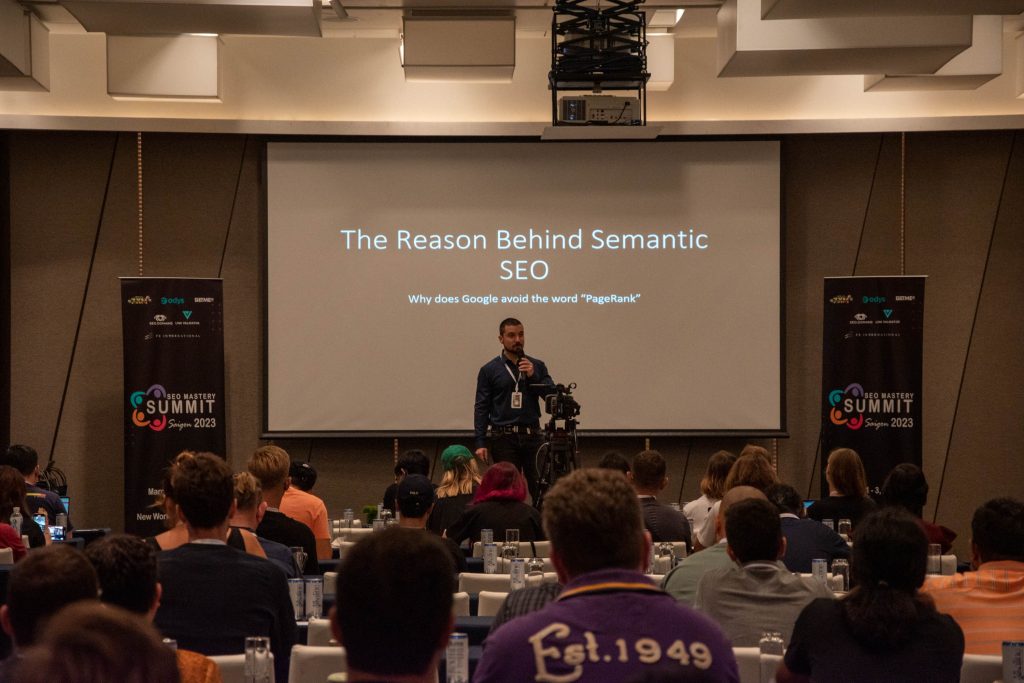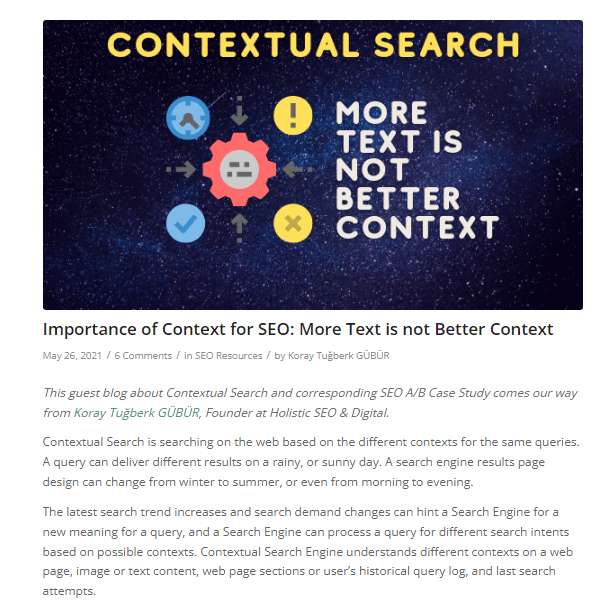SEO Course: Advanced Semantics with Results, Theories and Practice
Advanced Semantic SEO Course with more than 40 hours of SEO lectures, explanations, and examples.
Study Semantic Search Engines
Semantic SEO Course is designed to teach every detail of Semantic Search Engines' query processing methods. Understand Information Retrieval and Extraction.
Learn Query Semantics
Query Semantics rely on Semantic Distinctiveness and Relatedness. Understand the context vectors, contextual domains, coverage and flow. Understand query and term weights in semantics.
Create Semantic Content Networks
Semantic Content Networks represent every declaration, question, answer, structured content item within a network of content.
Semantic SEO Course Introduction
Semantic SEO Course has been created for the people who demand it. A person who knows the basic understanding of the search engine optimization might not understand the Semantic SEO properly. Thus, there is a high-level of theoretical education for the Semantics. At the right side, you can find a video introduction for the announcement of the Semantic SEO Course. The questions for Semantic SEO has been answered within the course with expanded information.
What to Know About Semantic SEO Course
Read the Questions and Answers along with the Testimonials, SEO Case Studies, and Suggestions for Semantic SEO Course and Learning.
Koray Tuğberk GÜBÜR is the Owner and Founder of Holistic SEO & Digital. Holistic SEO includes all verticals of SEO with different aspects and perspectives such as Technical, Local, Image, Video, Social and Semantic Optimization. Semantic SEO is one of the expertise areas of the Koray Tuğberk GÜBÜR. After publishing, 5 different SEO Case Studies with more than 70000 words and 9 successful websites, he created the Semantic SEO Course.
Semantic SEO Course has been created for the people who enjoy learning new things for SEO. Semantic SEO Course demonstrates a systematic methodology and understanding with the Search Engines’ semantic understanding. The ones with SEO Experience over 4 years, and a vast-level of information for the search engine functions can understand the semantic SEO Course better.
You should buy Semantic SEO Course for learning the Semantic SEO Implementation. From Lexical Relations of Words, to the Query Semantics, and Query Processing methodologies, a search engine’s ranking methodologies will be processed.
Yes, you can fail to implement Semantic SEO. The main reason of the failure for the Semantic SEO Implementation happens due to impatience. Semantic SEO relies on vast understanding of the linguistics and Information Retrieval, Extraction and Factual Ranking Algorithms. Thus, if you are not a patient person with a background of Semantics, 95% of chance, you fail. To prevent the failure in the Semantic SEO, the one needs to learn the basics of Semantics with a repeating practice schedule.
Patience. The hardest thing for implementing the Semantic SEO is patience. To understand the semantic SEO, the hardest thing is loving the linguistics. If a person is not patient and doesn’t love the linguistics, learning the Semantic SEO is harder.
Understanding a sentence structure is a fun activity for a Semantic SEO. Without understanding the Semantics, an SEO can try to imitate the competitors to have more featured snippets. But, if the semantics can be understood, it means they will be able to have more capacity to innovate the SERP.
Learning Semantic SEO can take different time based on the capacity, talent and background of the Semantic SEO student. A person with 4 years of SEO Experience, and learnings with Search Engine Patents, and linguistics can learn Semantic SEO under one year. A person with basic understanding of Search Engines needs to spend over 2 years to understand Semantic SEO fully.
Yes, you can ask questions related to Semantic SEO. Semantic SEO Course buyers are part of a Semantic SEO Learning community. They will be part of the continuous learning process to help other Semantic SEO learners.
SEO Course Testimonial Videos
SEO Course Testimonial videos are to provide the details related to the experience of learning Semantic SEO with Search Engine Understanding.
Dean Scatudo Semantic SEO and Koray Tuğberk GÜBÜR Testimonial

Jeff Oxford Semantic SEO and Koray Tuğberk GÜBÜR Testimonial

John Coburn Semantic SEO and Koray Tuğberk GÜBÜR Testimonial

Onur Güler Semantic SEO and Koray Tuğberk GÜBÜR Testimonial

Paul Jensen Semantic SEO and Koray Tuğberk GÜBÜR Testimonial

Ben Stace Semantic SEO and Koray Tuğberk GÜBÜR Testimonial

Kevin Farrugia Semantic SEO and Koray Tuğberk GÜBÜR Testimonial

Çağada Kırım Semantic SEO and Koray Tuğberk GÜBÜR Testimonial

Stephan Johnsen Semantic SEO and Koray Tuğberk GÜBÜR Testimonial

Christopher Prasad Semantic SEO and Koray Tuğberk GÜBÜR Testimonial

Jamal Qureshi Semantic SEO and Koray Tuğberk GÜBÜR Testimonial

Anonymous Testimony Semantic SEO and Koray Tuğberk GÜBÜR

Bünyamin Gökçül Semantic SEO and Koray Tuğberk GÜBÜR Testimonial

Hüseyin Bayram Semantic SEO and Koray Tuğberk GÜBÜR Testimonial

Semantic SEO Case Studies and Results
Importance of Topical Authority - 4 Websites with Semantic SEO
Importance of Topical Authority SEO Case Study conceptualizes the overall logic and the understanding of the Sub-topics (neural nets) update of Google with the help of Semantic Search Engines. The Importance of Topical Authority SEO Case Study has acquired the results below.
- Site 1 – From Monthly 0 to 200,000 organic traffic per month in 5 months.
- Site 2 – From 0 to 333,000 Monthly Organic Traffic in 5 Months.
- Site 3 – From 10,000 to 70,000 per month in 5 months.
- Site 4 – 400% Organic Traffic Increase in 5 months.
To read the short version of the Importance of Topical Authority SEO Case Study, use the image link below.
The Long Version of the Topical Authority SEO Case Study
The long version of the Semantic SEO Case Study and Importance of Topical Authority article explains the definition of the semantics for SEO with a deeper look. To read the long version of the Importance of Topical Authority Article, use the image link at left.
- 15,000 words
- 64 subsections.
- 4 websites with over 500% organic click increase on average.
- Pure Semantics and Language Understanding with Algorithmic Authorship
Importance of "Entity-oriented Search" - Becoming 6th Largest E-commerce Website of Turkey
Entity-oriented Search is defined by the Krisztian Balog. With the Entity-oriented Search Understanding, the Semantic SEO methods and the concepts are used for e-commerce. By creating the pairs of books, authors, genres and the contextual connections, the BKMKitap.com SEO Case Study has been created. And, the company became the sixth-largest e-commerce company in Turkey. BKMKitap.com has lost many Broad Core Algorithm Updates before we implemented the Semantic SEO Concepts.
During the Project, a 400% organic search performance increase has happened that is equal to gaining of millions of organic search sessions.
To read the Importance of Entity Oriented Search, use the link at left.
The Importance of a Holistic Approach and Clear Communication to SEO Success
Holistic SEO Case Study has been created by implementing multiple SEO Methodologies and verticals. Technical SEO is one of the fundamental ones for the specific SEO Project. But, Semantic SEO put the definitive results for the project itself. Encazip.com is an electric bill comparison and saving affiliate company. As an aggregator, the market is already one of the highest competitive markets. Thus, the competitors have lost all of their traffic.
The company has lost its gaining in terms of Technical SEO during a site migration process, but still, it continues to rise with the help of Semantic SEO. To read the Holistic SEO Case Study, use the image link at the left.
Creating Semantic Content Networks - Two Websites with Semantic SEO
Semantic Content Networks involve optimizing every sentence with a proper Contextual Vector, Hierarchy, Coverage and Flow along with providing a proper Contextual Connection. Context is all for Semantic SEO. Creating Semantic Content Networks SEO Case Study involves two different websites.
- Site 1 – From 0 to 350,000 monthly traffic within 8 months with over 40,000 new queries.
- Site 2 – From Daily 1,500 Clicks to 12,000 clicks in 6 months with new 75,000 new queries.
Creating Semantic Content Networks SEO Case Study is the most important SEO Case Study that is connected to the Semantic SEO and Course until now. To read the Creating Semantic Content Networks Case Study, use the image link at the left.
Creating Semantic Content Networks - Long Version with Search Engine Ranking Algorithms (Includes One More Website)
Creating Semantic Content Networks, long version focus on the Semantic Networks with the help of the Initial Ranking and the Re-ranking Algorithms. It explains what is the Initial Rank, and Re-rank factors for a search engine, and how to leverage both of them via Semantic Content Networks.
With an extra website, the results can be seen below.
- 10,000 Queries, Daily 300 Clicks, 40,000 Impressions in 20 Days (Initial Ranking), İstanbulBogaziciEnstitu.
- 33,000 Queries, Daily 11,000 Clicks, 150,000 Impressions in 65 Days (Re-ranking), İstanbulBogaziciEnstitu.
- 3,500 Queries, Daily 200 Clicks, 2100 Impressions in 30 Days. (Initial Ranking), Vizem.net.
- 32,000 Queries, Daily 5,000 Clicks, 54,000 Impressions in 30 Days. (Re-ranking), Vizem.net.
- 416,000 Queries, Daily 2,000 Clicks, 890,000 Impressions in 45 Days. (Initial-Ranking), Site-3 (Not disclosed).
- 185,000 Queries, 1000 Clicks, 201,000 Impressions in 6 months. (Initial-Ranking), Site-3 (Not disclosed).
The third website will be explained with the help of Query-Document-Intent template pairs.
To read the long version of Creating Semantic Content Networks, use the image link at left.
Multilingual SEO Case Study with 44 Different Languages
Multilingual SEO Case Study focuses on different verticals of multilingual SEO Efforts. It explains how to use a search engine’s perspective for Language and Audience Matching. Language Score, Symmetry of Different Language Sections, and distribution of relevance with ranking signals across different language sections are the main focuses of the Multilingual SEO Case Study.
The total increase is over 550% in 6 months. To read the Multilingual SEO Case Study, use the image link at the left.
Multilingual SEO Case Study with 44 Different Languages - Long Version
Multilingual SEO Case Study Detailed Version focus on different aspects of a Search Engine for query augmentation, and query log unification. How a search engine can close the information gap between different national SERP instances, and how they can use the multilingual websites for learning the concepts. Semantic SEO is language-agnostic, and focuses on entities. Thus, having semantics and multilingual SEO together is crucial.
To read the detailed version of the Multilingual SEO Case Study, use the image link below.
Google Core Updates: Effects, Problems and Solutions for YMYL Sites
Google Core Algorithm Updates can be a great strategy for SEO. If a website loses the Broad Core Algorithm, the lost organic traffic can be gained in the next Broad Core Algorithm Update. To change the last decision that the search engine made for the rankings, the website needs to be optimized and changed based on the agenda of the search engine by following its nature. Semantic SEO is one of the keys, along with the Technical, Local and the Branding SEO. The SEO Case Study below shows how the biggest Credit and Loan application aggregator dominated the industry with over 350% organic traffic increase and entirely new 20,000+ queries.
To read the Broad Core Algorithm Update SEO Case Study, use the image link below.
How to Become a Winner from Every Google Core Algorithm Update
To become a winner from every Google Broad Core Algorithm Update, the cost of retrieval is one of the fundamentals. The Second Article of the Broad Core Algorithm Update SEO Case Study focuses on the results, and the cost a website creates. The semantic SEO understanding and the search engine perspectives can be seen with early versions.
To see the results with a better understanding, use the image link below.
Importance of Ranking Signal Consolidation, Web Entity Hierarchy and Clean URL Structure for Better Communication with Search Engines
The Ranking Signal Consolidation SEO Case Study focuses on the Relevance and Distinctiveness of queries from each other. It explains the cost of retrieval via duplicate content, and unnecessary URLs. The contextual signals of the URL Structure are processed with a new SEO Perspective. It explains the Semantic SEO from a “Canonical Query and Intent” perspective.
The results of the Ranking Signal Consolidation can be seen below.
- You will see how SEO Theories Theoretical Information and Technical SEO can create 296% Organic Traffic Growth in YoY Comparison. (Between 1 Jun – 1 September 2019 and 1 Jun and 1 September 2020.)
- It can decrease your organic traffic by 35.51% in one month.
- It can create 33.33% Organic Traffic Growth in one month and 66.24% in four-month.
- Also, we will see an organic-based Direct Traffic increase of 40% annually.
To read the Ranking Signal Consolidation SEO Case Study, use the image link below.
The Importance Of Technical SEO: Insights Of Technical Issues Of Unibaby Project
Technical SEO supports Semantics. The Unibaby SEO Project is one of the early SEO Case Studies that I have written from different perspectives. And, these SEO Case Study parts explain the prominence of the integrated SEO Efforts. Unibaby s a brand for mothers, and mother-baby products. By providing the first models of the Semantic Content Networks and the Technical SEO support, 195% organic traffic increase in 2 months is acquired.
To read the Technical Part of the Unibaby SEO Case Study, use the image link below.
Importance Of User Experience, Authoritative Content And Page Speed Improvements For A Rapid Organic Traffic Growth: Unibaby Project
User Experience and Authoritative Content is the second part of the Unibbay SEO Case Study. It explains how the content is made more authoritative, and how it is supported with a better User Experience.
Understanding the UX Connection to Semantic SEO, use the image link below.
How A Web Entity Can Grow Traffic And Lose Google Core Algorithm Update At The Same Time
To understand the Semantic SEO Course, understanding the UX and Technical SEO Aspects of the SEO Projects is a must. Thus, reading the Unibaby SEO Case Study parts is suggested. The last part focuses on the understanding of the Broad Core Algorithm Updates. It explains that the traffic increase with the new content publications doesn’t guarantee a win for broad core algorithm updates.
Contextual Search Engines and Consolidating Context for Better Relevance and Coverage
Contextual Search Engines involve understanding different possible search patterns based on neural nets, and conceptual connections. Every contextual domain is connected to each other with context layers and knowledge domains. A knowledge domain consists of concepts, and topics. A contextual domain consists of a concept, topic, and context qualifier.- 100 URL samples increase its organic traffic between 60% and 140%.
- Adding contextually relevant question and answer pairs.
- Understanding search intent and document templates.
- 43 Different Contextual Search Factors for Search Engines
SEO Researches and Methodology Guides
SEO and Data Science for Understanding Google Algorithms
Use Python to understand Google Algorithms with concrete data. How Google Ranks the different types of websites, crawl websites, extract and aggregate the data to visualize the Google Decision trees.- 30,000+ Words of Research for Google Algorithms.
- 126 Sub Sections
- 2000+ Lines of Code
- 500+ Data Visualization Samples
- Automated SERP Scraping and Rank Comparison for Understanding Google Decision Trees
Google Author Rank and Perception of Authorship for Search Engines
How does Google know who has written the article? What is Google Author Rank? Google Author Rank is a research and case study to explain the authorship skills of a search engine for better ranking and authority.- 17,000 words of research for Google’s Algorithms for authorship and expertise.
- 35+ subsections to explain related Google Research Papers, and Patents.
- Unique Approach for Natural Language Processing and Understanding technologies to measure search engine capabilities for stylometry.
- Real-world cases to understand the authorship based on evidence such as word sequences, or vectors.
Lexical Semantics and Semantic Similarity Case Study with 29 Projects
Lexical Semantics involve hypernyms, hyponyms, holonyms, meronyms, synonyms, antonyms, and other lexical units for increasing the relevance and responsiveness for a specific query, and its interpreted versions by a search engine query processor. The SEO Case Study involves over 29 projects and the number continues to increase.
- Learn Lexical Semantics for creating topical maps.
- Understand how to use contextual hierarchies.
- Examine naked domains that are successful with lexical semantics.
- Learn their topical maps to understand further.
B2B SEO Case Study
- 115% Organic Click Increase in 3 Months YoY Google Search Console Performance Comparison
- 97.6% Organic Impression Increase in 3 Months YoY Google Search Console Performance Comparison
- 36,000+ New Organic Search Queries
- 1126 New Top 3 Ranking Organic Search Queries
- 2665 New Between 4-10 Organic Search Queries
- 34,000 New 10-100 Organic Search Queries
- And, many more results with 2023 Core Updates.
SaaS SEO Case Study
SaaS SEO Case Study is to provide methodologies for ranking SaaS Businesses with semantics, technical, branding and local SEO approaches. Creating brand search demand, and optimizing a surround sound for the company’s relevance, and authority for ranking algorithms, creation of a topical map, and internal link design, together with content brief creation is involved.
- Learn how to create topical maps for SaaS Companies.
- Learn Brand Positioning by even changing Google auto-suggestions.
- Understand How to position a company as authority for its own industry.
- Learn creation of Company Thought Leadership via Semantic Content Networks.
Semantic Search and Verbs Case Study
The Case Study involves 8 Different Projects with success. The topical maps are explained in the context of the context augmentation, and context shaerpening with chosen predicates. It explains how search engines changed their indexation engine, and how it works for classification of the articles.
- Semantic search uses natural language queries based on behavior patterns.
- Google has reported an increase in natural language queries each year.
- The Association of things in knowledge representation comes in different methods.
- The Semantic Search for Semantic SEO guide involves an SEO Case Study from a Semantic Content Networks article.
- Military discipline is required for Semantic Search Algorithms of Google.
Exact Match Domain SEO Case Study
he SEO case study explores the benefits of using Exact Match Domains (EMDs) to improve search engine rankings. An EMD involves phrases with high search volume in the domain name, and can rank higher than other branded term domains. The case study reports impressive results, including over 10,000 organic search queries, 80+ indexed web pages, and ranking for synonyms of the EMD phrase. The project also achieved 1000+ direct sessions for the brand and breaching 100,000 impressions in the first month.
- Having 100+ daily clicks on the 7th day of the project.
- Despite there being 10 different brands using the same phrase on the domain name, coming to the first SERP page in one week.
- Breaching 5,000+ organic clicks in the first month.
- Breaching 100,000 impressions in the first month.
- Having 7,000+ organic queries in the first month.
- Ranking for the synonyms of the Exact Match Domain phrase.
- Acquiring 1000+ direct sessions for the brand.
- Indexing 80+ web pages on the 3rd day of the brand launch.
- Reaching out 700 Clicks a day in the 6th month of the project.
- 10,358 Organic Search Queries are acquired.
- 1115 Ranked Queries between 4-10 in 6 months.
- 377 Organic Search Queries are ranked between 1–3 rankings in 6 months with exact matching domains.
- During the project, the total referring domain count was and is lower than 100.
- The Domain Rating Score of Ahrefs is 4.1, while SEMRush’s Authority Score is 23.
- The total Referring Domain is 96, the Backlink count is 453.
Holistic SEO Case Study
Holistic SEO Case Study is an example of Holistic SEO approach for a start-up in insurance, energy, and credit industry by optimizing every pixel, byte, letter of a web entity by including the investors, founders’ identities for a better entity-oriented search. Technical SEO, Local SEO, Semantic SEO, Brandship and PageRank for Authority creation are organized and implemented for higher rankings successfully.
- From daily 200 clicks to 20,000 organic clicks are achieved.
- Over 100,000 organic search queries are achieved.
- Site Migrations, Semantic Content Network creation, Topical Map expansion, Brand Identity changes are experienced.
- Re-design, web page layout optimization, conversion rate optimization are implemented.
Entity Identity Creation Case Study
Entity Identity Resolution is a process of recognizing an entity with its type, attributes, and values. It’s a necessary step in the process that is distinct from named entity recognition. The optimization and control of identity shifts and changes in knowledge bases based on document statistics are known as entity identity management. The SEO case study examines how document and query statistics create search memory in search engines’ entity resolution algorithms and how it affects the Brand SERP and Knowledge Panel Management. The study highlights the issues caused by fake news distribution that harmed the entity’s digital reputation. The study also includes guides and case studies related to the Entity Identity Creation and Management for Knowledge Graph and Base control with document statistics. The case study provides conceptual definitions to explain entity identity resolution and management.
- A Dentist that is digitally slandered is defended by changing the Google’s perception.
- From an Ex-wife to Cosmetic Dentist perception is created.
- Semantic SEO is used against heavy PageRank news sources.
- Sentence structures, publication frequency, and consensus theories are used with heavy semantics.
Entity Attribute Value (EAV) SEO Case Study
Entity Attribute Value (EAV) SEO Case Study explains a different type of triples for Semantic SEO. Entity-attribute-value is a triple model as Subject-predicate-object. These triples help search engines to extract information, construct knowledge-bases, and organize information on the web in the form of ranked web documents and web answers. Understanding E-A-V helps for creation of topical maps, and increasing the relevance, and responsiveness for better rankings.
- E-A-V has a real-world one-o-one training lecture series with Dear Dean Anthony Scaduto, and Kevin Farrugia.
- Dean and Kevin implements certain methods that are taught by Koray Tugberk GUBUR.
- They get results in a healthy way, and they share results.
- E-A-V explains how it is used in this education and implementation SEO case study.
Topical Map Expansion and Topic Consolidation Case Study
Topical Map Expansion and Topic Consolidation case study examines 15 different websites’ topical maps by explaining their core, and outer topical maps, how entities, attributes, values, and predicates are used, what kinds of topics, and contextual domains are used.
- 15 Topical Maps are examined with core and outer sections.
- 15 Successful projects’ domains, and ranking changes, and organic traffic performances are given.
- 15 topical maps with all contextual, and knowledge domains, with predicates, phrase patterns, and semantics are explained.
- Frame Semantics, Inqusitive Semantics, Lexical Semantics are involved in the Case Study for SEO.
Video SEO Case Studies
Topical Authority: 15 Semantically Optimized Topical Maps for SEO
Entity Attribute Value (EAV) SEO Case Study – Semantic Content Networks with Templates
Exact Matching Domain SEO Case Study and Tutorial: Rank with Branding Search Terms
Entity Identity Creation and Management SEO Case Study – How to Change Google’s Perception?
Predicates for Frame Semantics: 8 Websites Between 3x and 5x Organic Traffic Growth
SaaS SEO Case Study: 2 SaaS Websites with 40x Traffic
B2B SEO Case Study and Guide: 350% Organic Click Increase
Query Semantics SEO Case Study: Convince Search Engine to Change Meaning of a Query – Two Websites
Holistic SEO Tutorial Step by Step and Case Study: From 10,000 to 500,000 Organic Clicks a Month
Lexical Semantics and Relations for Semantic SEO: 26 SEO Campaign in 1 Case Study
Entity Based SEO Guide: Entity-Oriented SEO Case Study by Exceeding 4 Millions Clicks a Month
Search Engine Trust and Historical Data: 350% Organic Click Increase without Publishing New Content
Keyword Difficulty: Quality Thresholds and Predictive Ranking of Search Engines – SEO Case Study
Google Author Rank: Understanding Google Authorship – How Google Evaluates Author Authority?
The video discusses Google Author Rank and how Google evaluates author authority. The concept of the main content creator is heavily used in Google quality rating and is relevant to the eat and authorship. The video mentions the history of Google Authorship since 2005 and discusses the different ranks used in research papers. The video highlights the importance of authorship and how Google uses author vectors to determine an author’s authentication score for a topic. The video also mentions the importance of identifying comments submitted by users and ranking them based on authenticity. The video suggests that understanding Google Author Rank is essential for optimizing your online identity in the eyes of Google.
How to Be a Topical Authority in Your Niche
Semantic SEO Strategy: Case Study – How Google Ranks
Semantic SEO – An SEO Case Study with Google’s Algorithm Analysis
SEO Books for Advanced Level Organic Search
Coming soon.



























